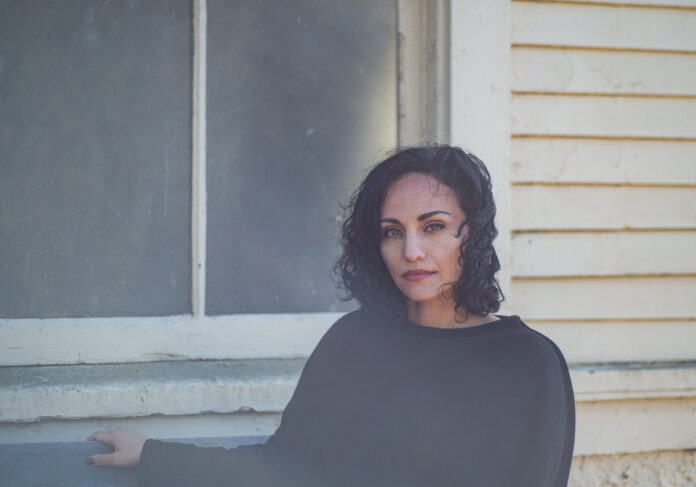Releasing an album is a terrifying proposition. The work to which you’ve devoted months or years of your time is now at the mercy of the public, which is free to praise or hate or misinterpret it at their own discretion. For Sholeh Asgary, who’s long used sound in her installation art but just released her first album آبـان (Aban), this October, the transition was even more complicated.
“In a performance space, I’m there with people, there’s a physical space,” says the Oakland-based artist and teacher. “When you have an exhibition, you see everyone in person and they’re seeing it, so a lot of things are felt in that space, and that guides the piece to some extent. Creating an album, I definitely had to think to myself: How do I get there?”
Aban—released on cassette and digitally via Bay Area art book publisher Sming Sming and local label crystalline morphologies—is a short and beguiling album of electroacoustic music, which seems to generate its own space and then occupies it like a low-hanging fog. Hazy and oneiric—and indeed inspired by some of the artist’s dreams, including a relatable nightmare about not being recognized at soundcheck—it’s defined by sounds that slip out in and out of pockets of silence.
Asgary’s voice emerges from the ether, snakes across the stereo field, and dissipates. A santur, an Iranian hammered dulcimer, flutters plaintively like a stray hummingbird. A siren becomes strings; a voice becomes an insect whine; doors open and close in the distance.
“It’s like a dream,” she says. “I feel like there are aspects of the album that might come into sharp focus and then fade out. It’s kind of like listening through noise.” (A release show for the album takes place 7:30pm, Sat/26 at Oakland’s Temescal Arts Center).
Asgary says her interest in insect sounds stems from the few years she spent as a child living in buggy Houston, Texas. The santur comes from Iran, where she was born; it’s not a cheap instrument to buy stateside, so all the santur sounds are either sampled or produced by an autoharp modified into a simulacrum of one.
Yet Asgary downplays the importance of these personal associations to one’s ability to understand the music.
“I think aspects of it have some personal connection to me, but I’m not sure how important it necessarily is to the listener,” she says. “To me, on this album, the significance isn’t so much of what they’re of, because they’ve been manipulated.”
This approach contrasts with the deeply personal strain of electroacoustic music that emerged during the pandemic via artists like Nick Zanca, Claire Rousay, and Nyokabi Kariūki (the latter of whom has shared a bill with Asgary), whose use of field recordings to bottle individual moments resonated with audiences acutely aware of the slippage of time during the lost years of 2020 and 2021.
It also contrasts with the thematically rich installation work she’s made her name on in the past. Last year’s Shabah e Baad (Ghost Winds), a six-channel sound piece at the Yerba Buena Arts Center, paid homage to Iranian waterways called qanats, which allow sustenance in rural eras and predate the Roman aqueducts by nearly a thousand years—and connected them to the “ghost creeks” of San Francisco, buried by colonialism.
“I’m actually using recordings of waterways,” she says. “I translated that into music notation in the piece, so that has a significance of where the source is from.”
Asgary was born in 1982 in Iran and had lived in several countries by the age of three, moving up to three times a year with her mother.
“I think being in this kind of movement I realized much later was something that felt very natural to me,” she says. “This is the longest time that I’ve lived in one place. I’ve been there for more than 10 years in my apartment now. Before that I hadn’t lived anywhere for more than four years.”
Asgary received her MFA in studio art at Mills College, long an incubator for great electronic and experimental music, and maintains a distinguished academic career, teaching several courses at UC Berkeley. She’s also on the curatorial council of Southern Exposure, the long-running art space in the Mission.
Despite working with sound extensively in her career as an installation artist, she only began working on Aban in May 2023, after years of fielding questions about whether or not she had any recorded material. Much of the bedrock of the album was composed in a single day, in a state that Asgary describes as a “flurry”—not a bad descriptor for the album itself, whose long tracks move as if being blown across a canvas.
“I’m not sure how to articulate it, but it felt like it needed to come out,” she says about the work. “It felt like a voice that needed to be there.”
آبـان (ABAN) RELEASE SHOW with Leila Abdul-Rauf, Thea Farhadian, and Silvia Matheus, 7:30pm, Sat/26, Temescal Arts Center, Oakland. More info here.




